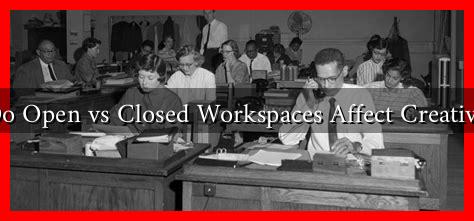-
Table of Contents
- How Do Open vs Closed Workspaces Affect Creative Flow?
- The Open Workspace: A Double-Edged Sword
- Benefits of Open Workspaces
- Drawbacks of Open Workspaces
- The Closed Workspace: A Sanctuary for Creativity
- Benefits of Closed Workspaces
- Drawbacks of Closed Workspaces
- Finding the Balance: Hybrid Workspaces
- Conclusion
How Do Open vs Closed Workspaces Affect Creative Flow?
In recent years, the design of workspaces has evolved significantly, with many organizations opting for open-plan offices in the belief that they foster collaboration and creativity. However, the debate between open and closed workspaces continues to be a hot topic among business leaders, architects, and employees alike. This article explores how these two workspace designs affect creative flow, drawing on research, case studies, and expert opinions.
The Open Workspace: A Double-Edged Sword
Open workspaces are characterized by large, shared areas with minimal barriers between employees. Proponents argue that these environments promote communication and teamwork, which are essential for creative processes. However, there are also significant drawbacks that can hinder creativity.
Benefits of Open Workspaces
- Enhanced Collaboration: Open spaces encourage spontaneous interactions among team members, which can lead to the exchange of ideas and innovative solutions.
- Flexibility: These environments can be easily reconfigured to accommodate different team sizes and project needs, fostering adaptability.
- Cost-Effectiveness: Open offices often require less square footage and fewer resources, making them a more economical choice for companies.
Drawbacks of Open Workspaces
- Noise and Distractions: The lack of physical barriers can lead to increased noise levels, which may disrupt concentration and hinder creative thinking.
- Reduced Privacy: Employees may feel uncomfortable sharing ideas in a space where they are constantly being observed, stifling their creative flow.
- Burnout Risk: The constant stimulation of an open environment can lead to mental fatigue, reducing overall productivity and creativity.
According to a study by the University of Sydney, employees in open-plan offices reported a 32% increase in workplace distractions compared to those in private offices. This suggests that while open spaces may facilitate collaboration, they can also impede individual creative processes.
The Closed Workspace: A Sanctuary for Creativity
Closed workspaces, on the other hand, offer private offices or cubicles that provide employees with a dedicated space to focus on their tasks. This design has its own set of advantages and disadvantages when it comes to fostering creativity.
Benefits of Closed Workspaces
- Minimized Distractions: Private spaces allow employees to concentrate without the interruptions common in open environments, enhancing their ability to think creatively.
- Increased Privacy: Employees may feel more comfortable sharing their ideas and taking risks in a private setting, which can lead to greater innovation.
- Personalization: Closed offices can be customized to reflect individual preferences, creating a more comfortable and inspiring work environment.
Drawbacks of Closed Workspaces
- Isolation: Employees may feel disconnected from their colleagues, which can limit collaboration and the sharing of ideas.
- Higher Costs: Closed offices typically require more space and resources, leading to increased operational costs for companies.
- Rigid Structure: The fixed nature of closed workspaces can hinder flexibility and adaptability in team dynamics.
A study conducted by the Harvard Business Review found that employees in closed offices reported a 20% decrease in collaboration compared to those in open spaces. This highlights the potential trade-off between privacy and teamwork in fostering creativity.
Finding the Balance: Hybrid Workspaces
Given the pros and cons of both open and closed workspaces, many organizations are now exploring hybrid models that combine elements of both designs. These spaces often include:
- Collaborative Zones: Areas designed for teamwork and brainstorming, equipped with whiteboards and comfortable seating.
- Quiet Zones: Designated spaces for focused work, allowing employees to retreat when they need to concentrate.
- Flexible Layouts: Movable furniture and adaptable spaces that can be reconfigured based on team needs.
Companies like Google and Facebook have successfully implemented hybrid workspaces, resulting in increased employee satisfaction and creativity. By providing a variety of environments, these organizations cater to different working styles and preferences.
Conclusion
The impact of open versus closed workspaces on creative flow is complex and multifaceted. While open spaces can enhance collaboration, they may also introduce distractions that hinder individual creativity. Conversely, closed workspaces offer privacy and focus but can limit teamwork and idea sharing. Ultimately, the most effective approach may lie in creating hybrid environments that balance the benefits of both designs. By understanding the unique needs of their employees and fostering a culture of creativity, organizations can create workspaces that inspire innovation and drive success.
For further reading on workspace design and its impact on productivity, check out this article from Forbes.

